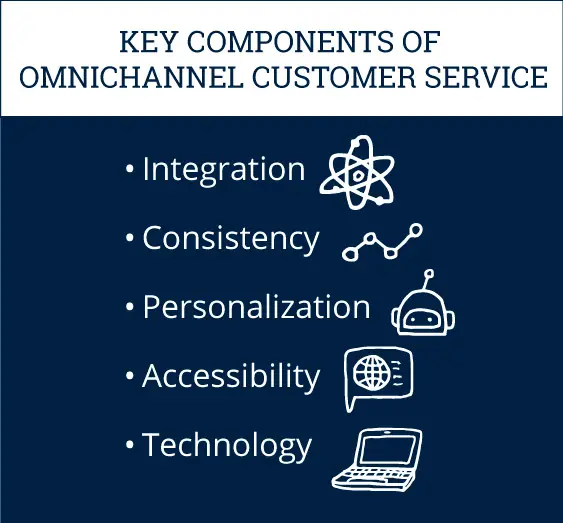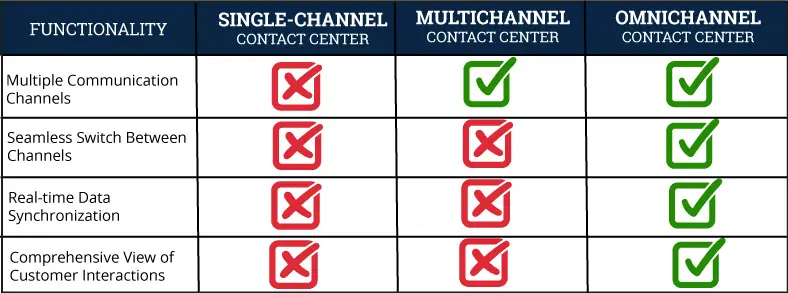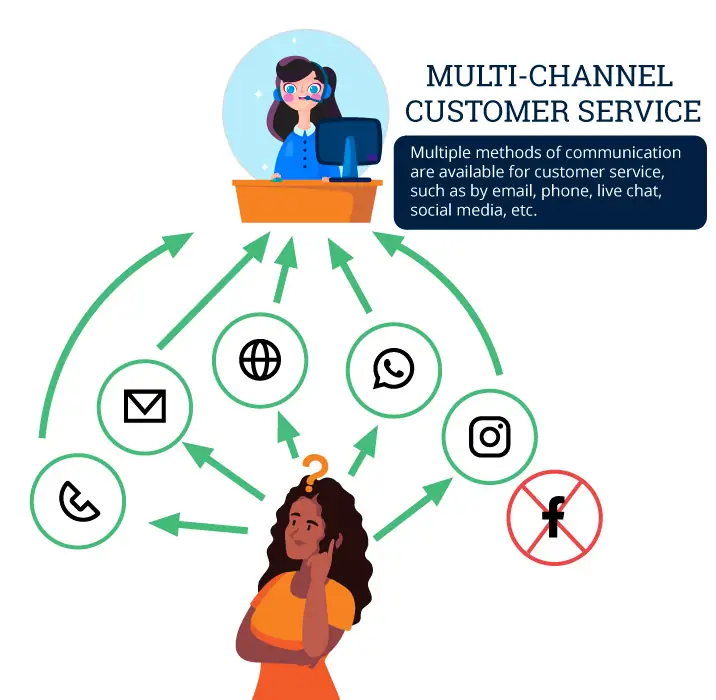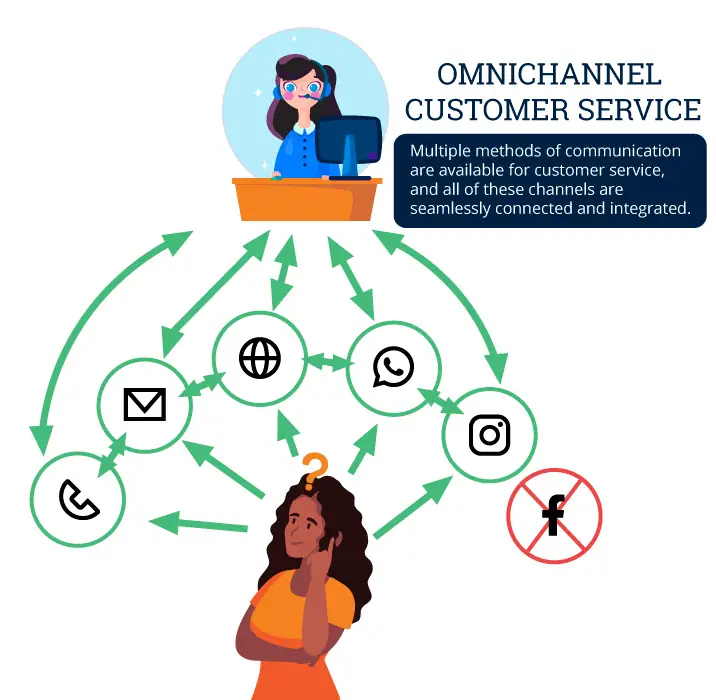Many companies have shifted from traditional customer engagement methods to "omnichannel" customer service, but what exactly does that mean?
Omnichannel customer service is an approach that provides a seamless, integrated experience across all channels of interaction. Unlike multi-channel or single-channel strategies, omnichannel customer service ensures that no matter how a customer chooses to connect - be it through social media, email, phone calls, or in-person visits - the experience is seamlessly connected, personalized, and highly responsive.
1. What Is Omnichannel Customer Service?
Omnichannel customer service is a customer support approach that provides a seamless, integrated experience across multiple channels and touchpoints. Unlike traditional customer service, which often operates in silos (phone, email, in-person), omnichannel customer service connects each of these channels.
Omnichannel customer service ensures that customers receive a consistent and unified experience, no matter how or where they choose to interact with a business. In practice, this means that a customer can begin their journey on one channel, such as live chat on a website, and switch to another, like email or phone, without disrupting service or repeating information.
To illustrate the concept of omnichannel customer service, let's take a look at this scenario:
Imagine a customer, let's call her Sarah, who needs assistance with a product she purchased online. Sarah first contacts the company through their website's live chat feature while browsing the product page. An agent promptly responds to her inquiry, providing helpful information and addressing her concerns.
Later that day, Sarah realized she had additional questions about the product's warranty coverage. She decides to call the company's customer service hotline. When she calls, the agent can look at Sarah's file from her phone number and quickly scan the summary of Sarah's previous live chat conversation. The agent seamlessly picks up the conversation from where they left off, providing further assistance and ensuring continuity in the customer service experience.
A few days later, Sarah encountered an issue with the product and needed immediate support. This time, she prefers to communicate via email. She sends a message describing her problem, and within minutes, she receives a personalized response from an agent who is knowledgeable about her previous live chat and phone inquiries. The agent not only resolves her issue but also follows up with additional information to ensure Sarah's satisfaction.
In this example, the company's contact center demonstrates omnichannel customer service by seamlessly integrating various communication channels (live chat, phone, email) and providing consistent support across each interaction. This approach allows Sarah to engage with the company in the most convenient way while ensuring a cohesive and personalized experience across all touchpoints.
SQM Group's research shows that, in 2023, only 39% of customers were very satisfied with their seamless omnichannel experience. The standard for a World-Class Omnichannel experience is a Csat rate of 48%. This means that most contact centers today still have a ways to go before they can consider themselves World-Class Certified Omnichannel Contact Centers.

SQM offers a Snapshot Call Center Benchmark Study to determine your contact center's current performance for KPIs such as Omnichannel CX Score, seamless rate, customer satisfaction, First Call Resolution, One Contact Resolution, and Net Promoter Score, and your performance is compared to call centers within your industry, all industries and world-class Csat-performing call centers.
A random sample of post-call customer service surveys is conducted with customers who have interacted with your call center within one business day of their interaction. One of the key strengths of SQM's survey process is that SQM uses open-ended customer feedback and a proprietary repeat contact tagging system to identify opportunities for reducing repeat contacts and improving omnichannel customer experience.
What Are the Key Components of Omnichannel Customer Service?
The success of an omnichannel customer service strategy rests on several key components:

- Integration: All channels (social media, email, phone, live chat, in-person) are integrated, allowing for data sharing and a cohesive customer view.
- Consistency: Providing a consistent experience and message across all channels ensures that customers feel familiar and comfortable, regardless of the channel they use.
- Personalization: Leveraging customer data to provide personalized interactions and recommendations across all touchpoints enhances the customer experience.
- Accessibility: Ensuring customers can easily switch between channels without losing service quality or information.
- Technology: The backbone of omnichannel customer service is advanced technology, such as CRM systems and AI, to synchronize interactions and data across channels.
2. Why Is Omnichannel Customer Service Important?
a) Omnichannel Customer Service Enhances Customer Experience
Adopting an omnichannel approach significantly enhances the overall customer experience. By offering a streamlined and integrated service across various channels, businesses can meet customers where they are, providing support in a way that's most convenient for them.
This ease of interaction boosts customer satisfaction and loyalty, as customers appreciate the effort put into making their experiences smooth and hassle-free. Furthermore, the personalization aspect of omnichannel service makes customers feel valued, as their preferences and purchase history are taken into account across all interactions.
b) Omnichannel Customer Service Meets Customer Expectations
Today's consumers expect a high level of service that only omnichannel customer service can provide. They assume that businesses will recognize them across all platforms and that their journey will be seamless, regardless of the channel.
This expectation spans not only the quality of service but also the continuity and personalization of interactions. By meeting these expectations, businesses can build a strong relationship with their customers, fostering loyalty and encouraging repeat business. Moreover, failing to meet these expectations can lead to dissatisfaction and ultimately drive customers to competitors.
c) Omnichannel Customer Service Improves Communication
Omnichannel customer service greatly improves communication between businesses and their customers. Businesses can offer more effective and efficient support by integrating various channels and ensuring they work together seamlessly.
Customers can choose their preferred method of communication, making them more likely to engage with the business. Additionally, by having a unified view of customer interactions across channels, agents are better equipped to resolve issues and answer queries, reducing response times and improving the overall quality of service.
3. Single-Channel vs. Multi-Channel vs. Omnichannel
In the labyrinth of modern customer service, understanding the nuances between omnichannel, multi-channel, and single-channel approaches is paramount.

A single-channel refers to using one method of communication for customer service, such as a telephone line. This approach, while straightforward, often falls short in meeting the diverse preferences of today's consumers.
For example, if a company only provides single-channel customer service, this could mean that the company is only contactable through email. That means if a customer wants to call the company or message them on social media, they will not have the option.

In contrast, multi-channel customer service refers to providing customer support through various communication channels such as phone, email, chat, social media, and more. However, these channels tend to operate in silos, with little or no integration between them, potentially leading to inconsistent service experiences.
For example, if a company provides multi-channel customer service, a customer could contact the company in multiple ways (i.e., by phone, email, live chat, etc.). However, these contact methods are not seamlessly connected, which means that if a customer calls the company one day and emails the next day, the company will not have a way of connecting the two interactions.

Omnichannel customer service takes multi-channel a step further by increasing the channels of communication and integrating them seamlessly. This ensures consistency and fluidity in customer interactions across all platforms. In essence, omnichannel acknowledges that customer engagement can begin in one channel and move to another as the customer prefers, without any compromise in service quality or information continuity.
For example, if a customer emails a company about product issues one day and then calls the company a few days later, the agent on the phone will be able to pick up the conversation where it left off by email. This is very convenient for the customer because it saves them from having to repeat themselves and re-explain their situation when they switch communication channels.

Omnichannel contact centers have higher Csat than multi-channel contact centers; however, most customers do not wake up in the morning and say they want to use two contact channels to resolve the same inquiry or problem. In other words, most customers want a One Contact Resolution to resolve an inquiry or problem. One Contact Resolution means one channel and one contact to resolve an inquiry or problem.
SQM research shows that when a customer’s call is resolved after only one contact (i.e., One Contact Resolution), those customers are “very satisfied” with their customer experience 55% of the time. Whereas 39% of customers are “very satisfied” with their customer experience when they have multiple interactions with a contact center and these interactions are seamlessly integrated (i.e., Omnichannel CX). On the other hand, only 28% of customers are very satisfied when their multiple interactions are not seamlessly integrated (i.e., Multichannel CX).
This proves that, although One Contact Resolution is still the most important factor in achieving high customer satisfaction, if multiple contacts are necessary, then an omnichannel customer experience is the way to go.

Benefits and Drawbacks
The omnichannel approach offers significant benefits, primarily in enhancing customer satisfaction and loyalty. By providing a unified customer experience across all channels, businesses can meet customers where they are, making interactions convenient and more personalized. This boosts customer retention and can increase sales, as a positive experience fosters trust and reinforces the customer's decision to choose your brand.
However, adopting an omnichannel strategy is not without its challenges. It requires substantial investment in technology and training, as well as a shift in organizational culture to break down silos between departments. The complexity of coordinating multiple channels can also introduce operational challenges, requiring continuous effort to ensure all channels are equally efficient and integrated.
4. How to Implement Omnichannel Customer Service
To transition to an omnichannel customer service model, businesses must adopt a customer-centric mindset. This involves mapping the customer journey to understand all the touchpoints a customer may interact with and identifying opportunities for seamless service delivery across these.
Technologies and Tools
Implementing an effective omnichannel strategy is heavily reliant on the right technology stack. Central to this is a robust Customer Relationship Management (CRM) system that integrates with all communication channels, collecting and organizing customer interactions into a single, cohesive view.
Artificial Intelligence (AI) and Machine Learning (ML) technologies are also invaluable, offering capabilities such as chatbots and predictive customer service, which enhance responsiveness and efficiency across channels.
Overcoming Challenges
Transitioning to an omnichannel approach is fraught with challenges, not the least of which is resistance to change. Training and change management initiatives are critical in addressing this, ensuring employees are equipped and motivated to adopt new practices.
Moreover, maintaining consistent quality across channels can be daunting. It requires the right technology and a stringent quality assurance framework that encompasses all customer touchpoints. If a customer receives fantastic customer service over the phone but experiences terrible service by email, this will reflect poorly on your company's overall customer service.
Lastly, data privacy and security are paramount concerns. As omnichannel strategies thrive on the seamless flow of information across channels, safeguarding customer data against breaches is essential to maintain trust and compliance with regulations.
